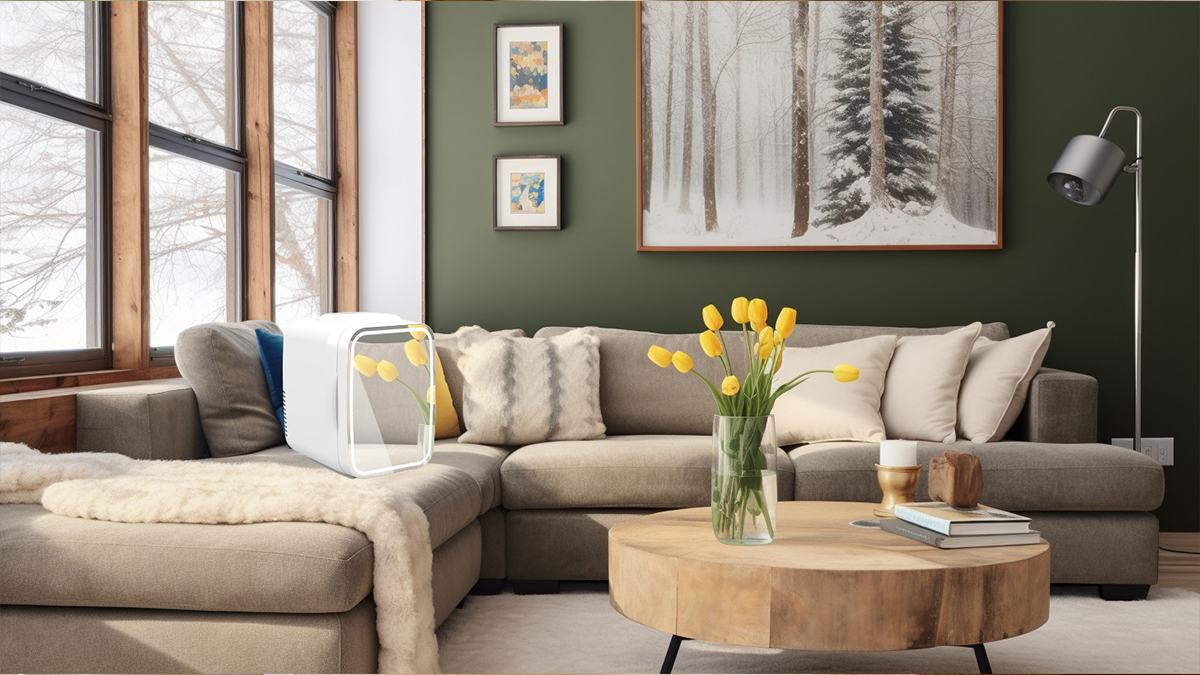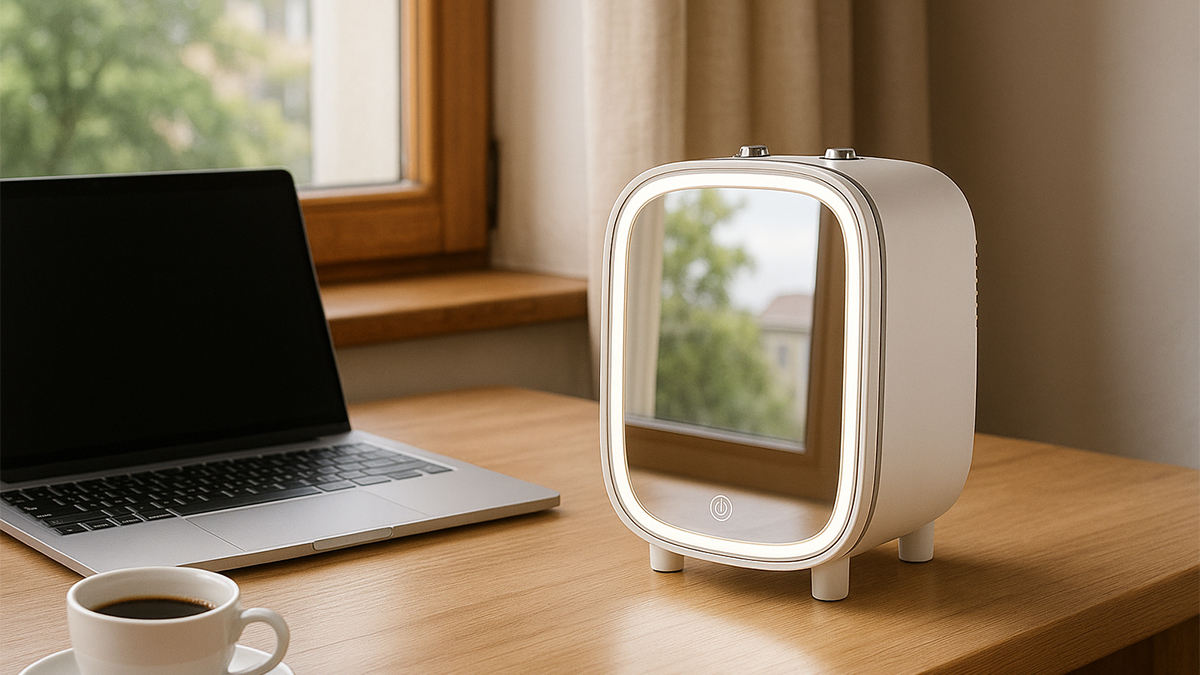Millennials, Gen Z, and urban consumers often choose a compact mini freezer for convenience and space-saving benefits. Individuals in small households or those seeking a portable mini fridge for flexible use also find value. Large families or those needing bulk storage may prefer a standard mini portable refrigerator.
Compact Mini Freezer Advantages
Space-Saving Design
A compact mini freezer offers a smart solution for those with limited space. Most models range from 3 to 5 cubic feet, with dimensions around 20–24 inches wide, 31–37 inches high, and 20–25 inches deep. This size allows the freezer to fit easily between kitchen cabinets, under counters, or in tight corners. In comparison, standard freezers start at about 10 cubic feet and require much more room. The vertical shelving in upright compact models helps users organize food efficiently without taking up extra floor space.
| Freezer Type | Size Category | Cubic Footage | Approximate Dimensions (W x H x D) inches |
|---|---|---|---|
| Upright Freezer | Compact | 3 to 5 | 20–24 x 31–37 x 20–25 |
| Upright Freezer | Small | 5 to 9 | 21–25 x 55–60 x 22–26 |
| Upright Freezer | Medium | 10 to 16 | 23–31 x 60–73 x 27–30 |
| Upright Freezer | Large | 17+ | 27–34 x 64–76 x 29–30 |
| Chest Freezer | Compact | 3 to 5 | 21–28 x 32–34 x 19–22 |
| Standard Freezer | Full-sized | 10 to 20+ | Larger dimensions, typically exceeding medium size |
This table shows how much less space a compact mini freezer needs compared to larger models.

Portability and Flexibility
Portability stands out as a key benefit. Most compact mini freezers weigh between 52.9 and 58.4 pounds, making them light enough for one or two people to move. Many models include handles or wheels, which help users relocate the freezer as needed. The small size allows the freezer to fit in vehicles, dorm rooms, or offices. Some models even work with car batteries or solar panels, making them suitable for travel or camping.
- Portable freezers usually range from 1 to 2 cubic feet.
- Handles and wheels improve ease of movement.
- Compact size fits behind car seats, in trunks, or small home spaces.
- Designed for travel, outdoor use, or flexible home placement.
Energy Efficiency
A compact mini freezer uses less energy than a full-size freezer. On average, these freezers consume up to 310 kWh per year, while full-size models use about 528 kWh or more. Many compact models feature manual defrost, which further reduces energy use. ENERGY STAR certified models are at least 10% more efficient than non-certified ones. Lower energy consumption not only saves money but also supports environmentally friendly living.
| Freezer Type | Average Annual Energy Consumption (kWh) |
|---|---|
| Compact Mini Freezers | Up to 310 kWh |
| Full-Size Freezers | Approximately 528 kWh or higher |
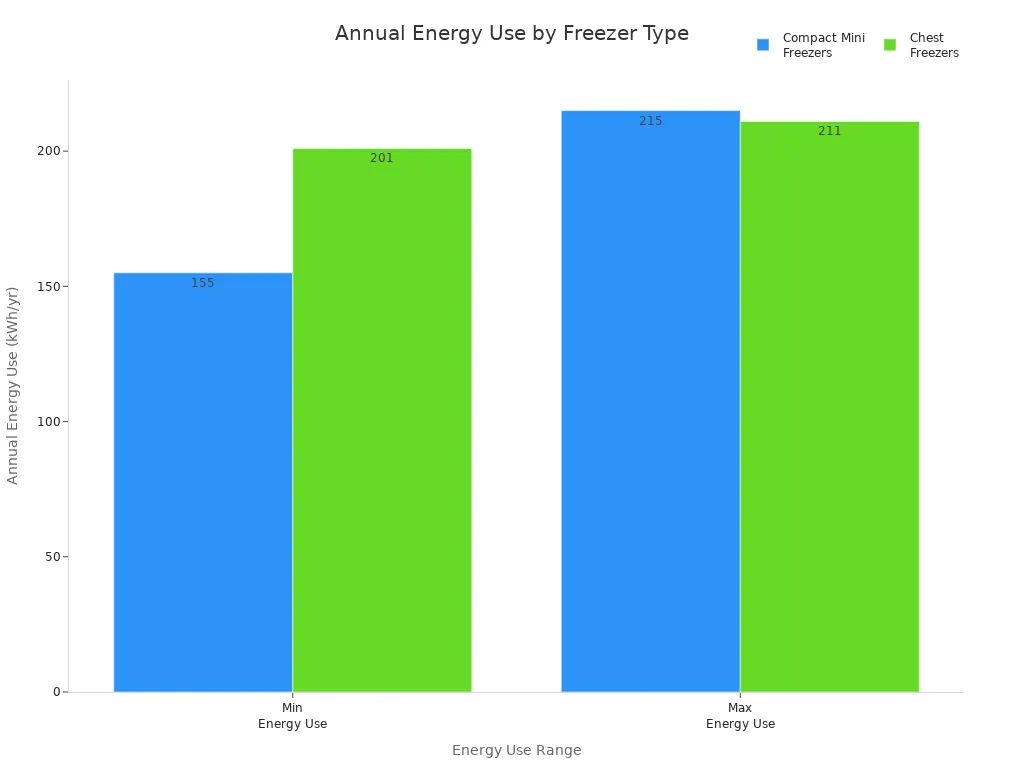
Cost-Effectiveness
A compact mini freezer provides a budget-friendly option for those who do not need bulk storage. Prices typically range from $170 to $440, depending on the brand and features. In addition to lower upfront costs, these freezers save money over time through reduced energy use and minimal maintenance. Annual operating costs can be as low as $37 to $75, and energy-efficient models may save $50-60 per year on electricity. Over several years, these savings can cover the initial purchase price.
| Product Model | Capacity (cu. ft.) | Price (USD) |
|---|---|---|
| Whirlpool Compact Mini Fridge | 3.1 | 169.99 |
| GE Double-Door Compact Refrigerator | N/A | 440 |
| Frigidaire 2 Door Retro Fridge | 3.2 | 249 |
| Galanz Retro Compact Mini Refrigerator | N/A | 279.99 |
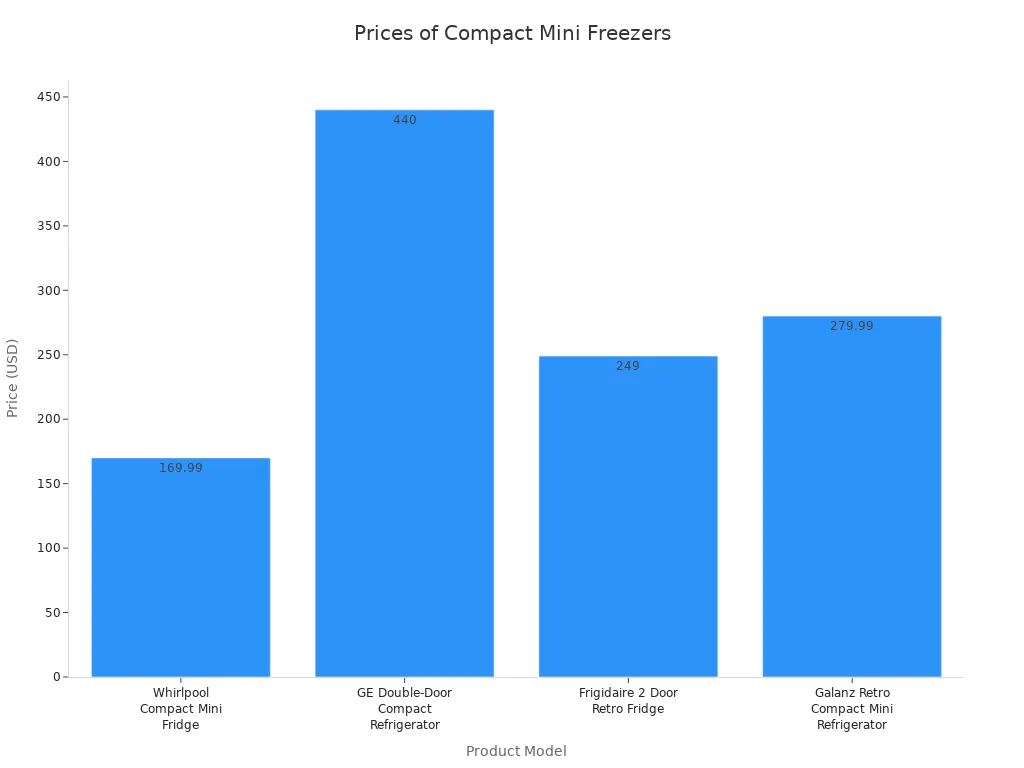
Tip: Regular maintenance, such as cleaning coils and checking door seals, helps keep energy costs low and extends the life of the freezer.
Convenience for Small Spaces
A compact mini freezer fits perfectly in small apartments, dorm rooms, offices, and even bedrooms. Its small footprint allows users to place it under counters, in closets, or next to desks. Many models combine refrigeration and freezer functions, reducing the need for multiple appliances. Users appreciate features like adjustable shelves, quiet operation, and stylish designs that blend with room decor.
- Ideal for offices, mini-houses, and mini bars.
- Stores drinks, snacks, and overflow food.
- Easy to clean and maintain.
- Noise reduction features support peaceful environments.
- Energy efficiency aligns with sustainability goals.
A compact mini freezer brings both function and style to limited spaces, making daily life more convenient for those with smaller living areas.
Compact Mini Freezer Disadvantages
Limited Storage Capacity
A compact mini freezer offers a storage capacity between 1.7 and 4.5 cubic feet. This size suits small households, offices, or dorm rooms. Standard freezers provide much more space, making them better for bulk storage. People who buy in bulk or store large quantities of frozen food may find the compact mini freezer too small for their needs. Users often manage limited space by organizing items with pullout drawers, removable shelves, and door storage bars. These features help separate meats, vegetables, and other foods, making it easier to find items quickly.
- Filing storage systems with drawers allow vertical stacking and easy visibility.
- Removable shelves and door bars secure bottles and maximize space.
- Organization features improve accessibility and help users handle limited storage.
Potential Noise Issues
Most compact mini freezers operate quietly, with noise levels similar to wine fridges. These appliances typically produce between 35 and 45 decibels, which matches the sound of a quiet office or library. Some modern chest freezers report noise levels below 40 decibels, making them suitable for bedrooms or offices. User reviews rarely mention noise problems. Many users describe their freezers as “very quiet” or “not very loud.” Occasionally, someone may notice a noise during the cooling cycle, but these reports are uncommon.
| Appliance Type | Typical Noise Level (dB) | Comparable Environment |
|---|---|---|
| Compact Mini Freezer | 35–45 | Quiet office, library |
| Standard Refrigerator | 40–50 | Normal conversation |
| Modern Chest Freezer | <40 | Library, quiet bedroom |
Temperature Fluctuations
Compact mini freezers often struggle to maintain consistent internal temperatures. Standard freezers keep a stable temperature around 0°F, which meets USDA recommendations for food safety. In contrast, compact models can fluctuate between 2°F and 22°F. These swings may cause freezer burn or uneven freezing. Some models run warmer than ideal, while others may freeze food in the refrigerator section. The following table shows temperature stability across several mini freezer models:
| Model | Fridge Temp (°F) | Freezer Temp (°F) | Stability | Notes |
|---|---|---|---|---|
| Magic Chef 3.1 cu. ft. | ~42 | Swings ~30 | Poor | Wide temperature swings |
| Midea 3.1 cu. ft. Double Door | 31 | Stable | Good | Fridge may freeze food |
| Frigidaire FFPE3322UM | 41 | 22 | Poor | Freezer not cold enough |
| Arctic King ATMP032AES | >40 | 3 | Good | Needs calibration |
| Midea WHD-113FSS1 | <40 | ~5 | Good | Stable but not ideal |
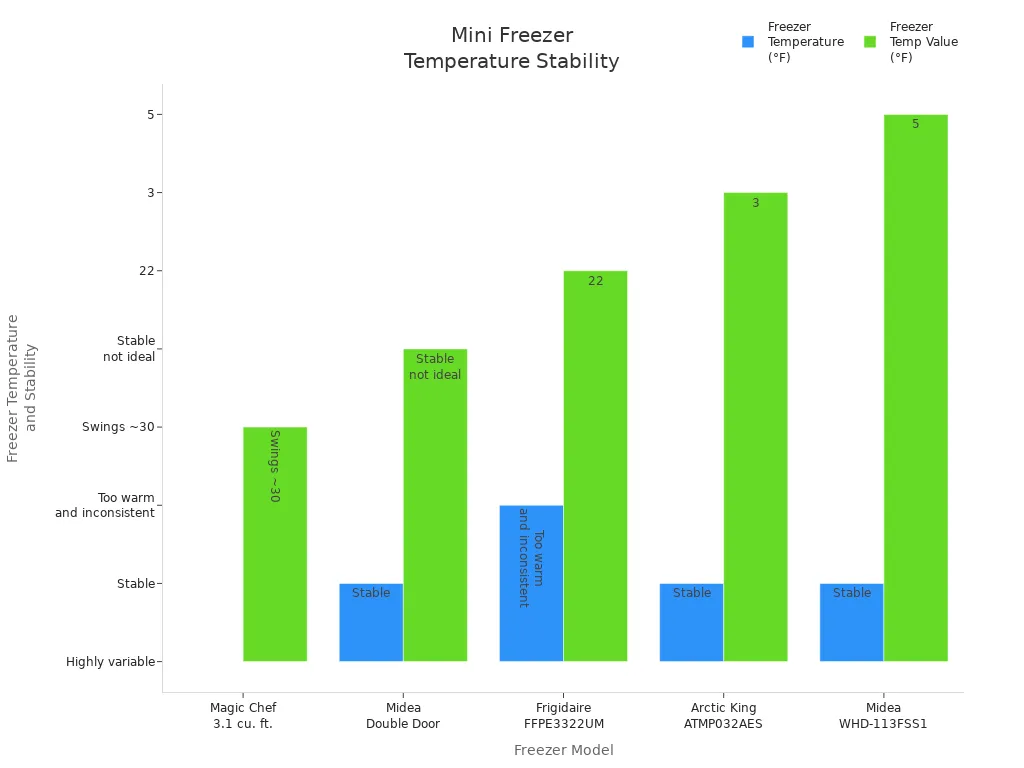
Maintenance and Manual Defrosting
Owners of compact mini freezers must perform regular maintenance to keep their appliances running efficiently. Manual defrosting is a common task, usually needed every three to six months. The process involves unplugging the freezer, removing all food, and allowing ice to melt. Users clean the interior with mild detergent or baking soda, dry it thoroughly, and then restart the appliance. Cleaning coils and checking door seals also help maintain performance.
- Open the freezer door and let ice melt, using towels or a pan to collect water.
- Speed up defrosting with a fan or gentle warm air.
- Remove shelves and drawers for cleaning.
- Clean the interior and door seals.
- Dry everything before reassembling.
- Turn the freezer back on and allow it to cool before returning food.
- Clean coils every three to six months.
- Check door seals regularly.
Some users prefer manual defrosting because it helps preserve food quality. Frost-free models may cause freezer burn or ice crystals, especially in items like ice cream. Proper wrapping and packaging of food can reduce these effects. There is a trade-off between convenience and food preservation.
- Self-defrosting freezers may partially thaw food, affecting texture.
- Manual defrosting can be done quickly with careful planning.
- Regular cleaning and organization help maintain food quality.
Not Ideal for Large Households
Large families or people who store bulk food may not find a compact mini freezer suitable. The limited capacity and temperature fluctuations make it difficult to store large quantities of frozen goods safely. These freezers work best for individuals, couples, or small households that need extra storage for snacks, drinks, or overflow items. For those with greater storage needs, a standard freezer offers more space and better temperature stability.
Note: Compact mini freezers provide convenience and organization for small spaces, but may not meet the demands of larger households.
Compact Mini Freezer Decision Guide
Assessing Your Available Space
Individuals should measure the width, depth, and height of the installation spot before purchasing a compact mini freezer. They need to allow a few inches of clearance around the freezer for proper air circulation. Door swing or drawer pull-out space must be considered for easy access. The path to the installation area, including doorways and hallways, should be checked to ensure the freezer fits through. Upright and chest models have different clearance needs, so matching the freezer type to the kitchen layout improves usability.
Tip: Compare the measured space with the freezer’s exterior dimensions and account for extra clearance to open doors or lids.
Evaluating Your Storage Needs
Users should assess household size and eating habits to estimate storage requirements. A single person or student may need less capacity than a couple or small family. The types of food stored, such as frozen meals or large cuts of meat, influence the ideal freezer size. Experts recommend allowing 1.5 to 2.5 cubic feet of freezer space per household member. Features like adjustable shelves and temperature control add flexibility.
- Measure available space and ventilation.
- Estimate storage needs based on lifestyle.
- Consider food types and frequency of use.
Considering Your Budget and Energy Use
Buyers must balance upfront costs with long-term operating expenses. Initial price varies by model and features, while energy efficiency ratings affect annual electricity bills. Frost-free models cost more but reduce maintenance. Energy-efficient models lower operating costs over the freezer’s lifespan.
| Mini Freezer Wattage | Annual Energy Use (kWh) | Estimated Annual Cost (USD) |
|---|---|---|
| 50 watts | ~146 | $25–$28 |
| 100 watts | ~292 | $50–$57 |
Warranty coverage and seasonal discounts can also impact total expenses.
Weighing Convenience Against Drawbacks
Users often weigh the convenience of quick access to frozen goods against potential drawbacks. Noise levels, energy consumption, and space limitations are common trade-offs. Selecting quiet models and ensuring proper installation can minimize disruptions. Realistic assessment of storage needs helps avoid overcrowding.
Checklist for Making Your Choice
- Measure installation space and clearance.
- Match freezer type to kitchen layout.
- Estimate storage needs per household member.
- Compare energy ratings and operating costs.
- Review warranty and support options.
- Prioritize accessibility and efficiency features.
Note: Careful evaluation ensures the compact mini freezer fits both lifestyle and space requirements.
A compact mini freezer offers space-saving design, portability, and energy efficiency. Some users may find limited storage and temperature swings challenging. Each person should review their space, storage habits, and budget. > For singles, students, or small households, this appliance often proves a smart choice.
FAQ
How often should users defrost a compact mini freezer?
Most users should defrost their compact mini freezer every three to six months. Regular defrosting helps maintain efficiency and prevents ice buildup.
Can a compact mini freezer run in a garage or outdoor space?
A compact mini freezer can operate in a garage or outdoor area if the temperature stays within the recommended range, usually between 50°F and 85°F.
What items store best in a compact mini freezer?
- Frozen meals
- Ice cream
- Vegetables
- Small meat packages
These items fit well and maintain quality in a compact mini freezer.
Post time: Aug-22-2025


